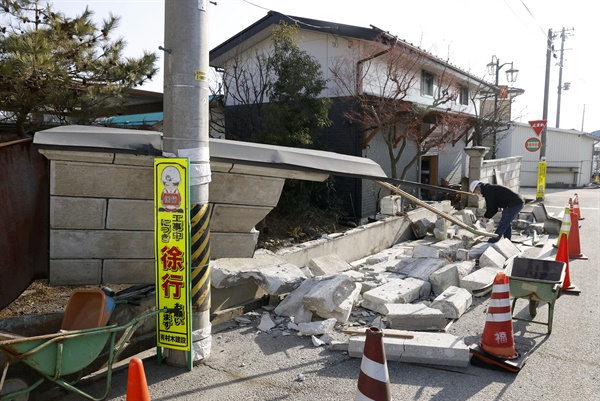|
View larger picture |
|
| ▲ A wall in a residential area in Fukushima Prefecture collapsed on the morning of the 14th, the day after an earthquake of magnitude 7.3 occurred off the coast of Fukushima Prefecture, Japan. | |
| Ⓒ Yonhap News |
See related photos |
There are many observations that it is the aftershock of the Great East Japan Earthquake that took place 10 years ago, including the Japan Meteorological Agency, over the earthquake of the 6 rivers (scale 7.1) that occurred off the coast of Fukushima, Japan on the 13th. This is a natural reaction because the memories of the cataclysm that struck Japan’s seaside cities along with the tsunami were lost.
On the other hand, there is a side of reassurance that an aftershock would be weaker than the main earthquake, but this is not an aftershock, but a more powerful earthquake will come in a few days.
Scientists from Japan, the earthquake-stricken country, have different opinions on this. However, the conclusion is that earthquakes continue in Japan, whether after earthquakes or main earthquakes. 16th <도쿄신문>Let’s hear the opinions of two Japanese scholars introduced in.
“This time it was only a 20cm tsunami, but…”
First, Kato Naoyuki, professor at the Earthquake Research Institute at the University of Tokyo, argues that it is an aftershock of the March 2011 Great East Japan Earthquake.
Professor Kato said, “When a major earthquake occurs, the fault moves and the force on the bedrock is redistributed, and the earthquake that occurred to release the force is an aftershock,” he said. “It is not strange even if it lasts more than 100 years.”
Professor Kato’s example was the “Nomi Earthquake” in October 1891 in central Japan and southern Gifu Prefecture. This earthquake, with a scale of 8.0, was the largest inland direct-type earthquake in Japan, killing 7,000 people in Gifu and Aichi Prefecture.
According to him, even 130 years later, “Aftershocks are happening in the present ongoing form.”
“The frequency is getting less and less, but aftershocks continue on a variety of scales, large and small,” he said, calling for a warning against the tsunami. However, in this earthquake, the tsunami stayed at the maximum height of 20 cm observed at Ishimaki Port in Miyagi Prefecture.
“There were very few tsunamis this time because the epicenter was deep and it took place inside the Pacific Plate, but if it happens in a shallow place like the main earthquake 10 years ago, the aftershock alone could deform the sea level and lift the water, resulting in a large tsunami.”
He said, “Because this is an earthquake on the Pacific plate, it is not directly related to the earthquakes under the capital and Nankai Trough (undersea gorge), which have been concerned,” he said. “The original cause of the earthquake in Japan is that the plate of the sea is inland. “It is not strange even if a big earthquake occurs anywhere, anytime, if the balance of power changes,” he warned.
“Possibility of an earthquake of a separate system… The same great earthquake as 10 years ago may come”
On the other hand, special professor Shimamura Hideki, a seismologist at Musashino University, is concerned about the possibility of an earthquake in a separate system caused by the main earthquake rather than the earthquake 10 years ago.
Paying attention to the fact that this epicenter is off the coast of Sanriku, Miyagi Prefecture, which is a support site for the Great East Japan Earthquake, he said, “There is a possibility that the power of the earthquake is moving outward due to the collapse of the balance of the plates that were keeping the balance by pushing each other underground.”
There is a’house’ in the earthquake, so shaking occurs in it, but it is said that there is a possibility that the’locks’ that held down the earthquake will be released in one place, triggering a new major earthquake in the north and south of the fault.
He said, “The main earthquake of the Great East Japan Earthquake may have been at a stage in which the north and south sides have also been released by releasing one lock,” he said. There is a possibility that the same huge earthquake will come.”
Meanwhile, Professor Takashi Furumura of the Earthquake Research Institute at the University of Tokyo told NHK, “It looks like an earthquake that occurred at the boundary of the plate when viewed from the epicenter or mechanism,” he said. “For the next week or so, it is necessary to pay attention to the violent shaking (at the level of 6 intensity). “He said.

